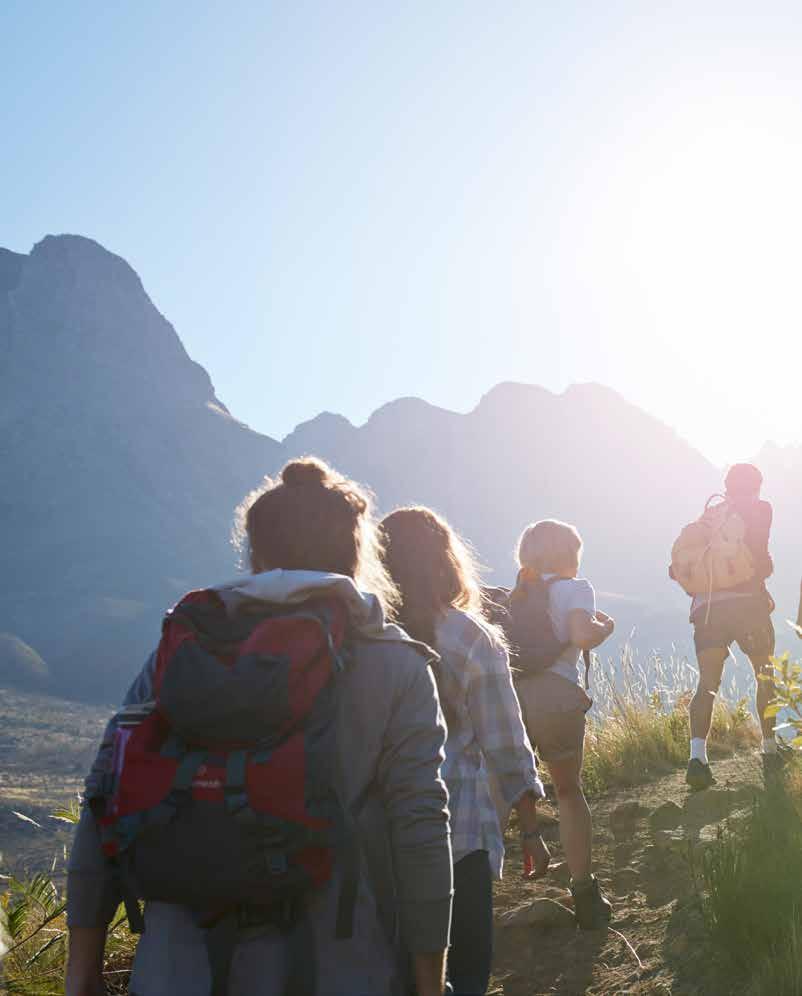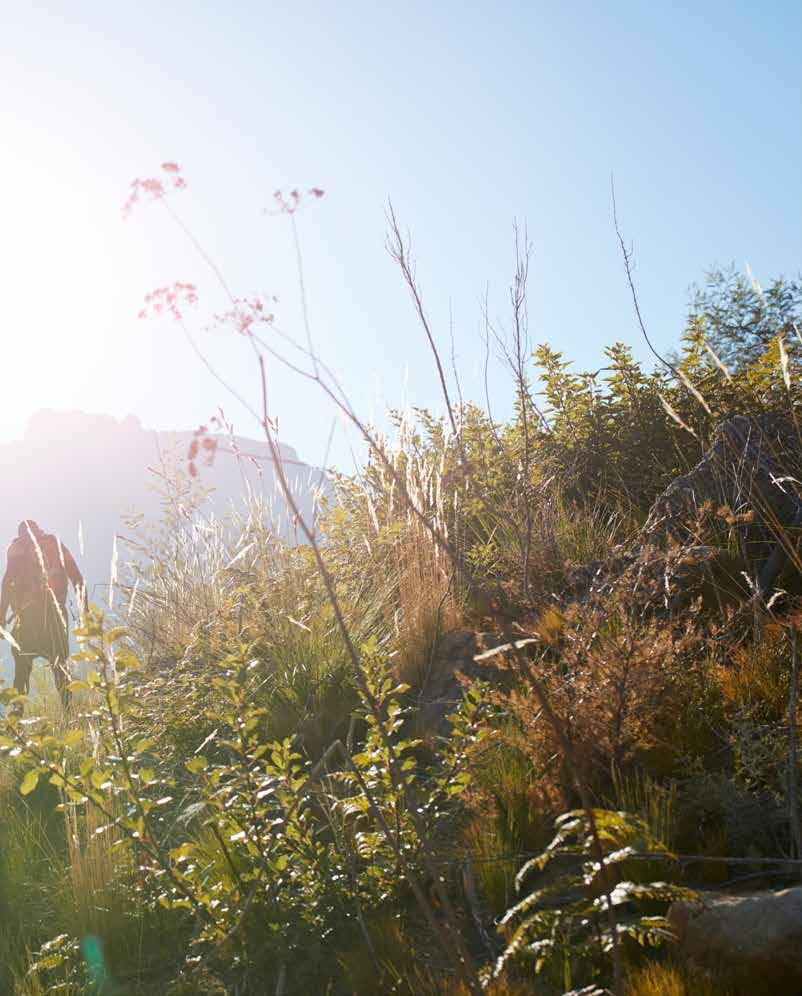
7 minute read
INTRODUCING HEALTHY JOURNEY
HEALTHY
by ASPEN VALLEY HOSPITAL
Living well is better with friends.
Wherever you live and whatever you do in the Roaring Fork Valley, our landscape weaves our lives together. Most of us socialize outdoors and our paths frequently cross while paddleboarding up Reudi, “hiking the Bowl” or picnicking at the Grottos. We can thank the trails, slopes, tracks and waterways of the valley for making an active lifestyle so enticing. But there is much more to achieving good health than staying fit. Written with you and our mountain terrain in mind, our team of doctors, physician assistants, nurses, paramedics, physical therapists, dietitians and medical writers are passionate about sharing their expertise and local know-how to encourage and support you on your healthy journey. From fitness and camping safety tips to healthy recipes for mind and body, Healthy Journey by Aspen Valley Hospital is here for you, your friends and your family so you can achieve optimal health at every age and stage of life.
GOODBYE SUMMER. HELLO WINTER.
Kicking off an epic ski or boarding season begins weeks before the snow even starts sticking. Ski- and board-conditioning is a minimal investment in injury prevention with the added benefit of starting at a higher level on your first day out. Turn the page to join our healthy journey to the slopes.
To explore more Health Journey topics and tools, visit aspenhospital.org/healthy-journey or scan this QR code.

HEALTHY
by ASPEN VALLEY HOSPITAL
Getting in shape for the ski season is a great way to avoid injuries and have more fun!
Aspen Valley Hospital physical therapist and ski patroller, Jack Michael, PT, DPT, tells you how.
With ski and snowboard season around the corner, you may be wondering what you can do to make those first few turns of the season a safer and more enjoyable experience.
Jack Michael, PT, DPT, has been a full-time physical therapist at Aspen Valley Hospital since December 2020. Jack grew up in Wisconsin skiing and racing and is now a volunteer ski patroller at Sunlight Mountain Resort outside of Glenwood Springs. Jack shares his expertise on ski conditioning below with some definite steps you can take to both avoid injuries and make your on-hill experience as enjoyable as possible.
Why is it important for people to get in shape for ski and snowboard season? First and foremost, being in better shape reduces your risk of injury. Additionally, you will experience less soreness and pain after a day on the slopes, and you will be able to ski all day.
What do you recommend for someone who has not done any pre-season ski training? If the ski season has approached a little quicker for you than expected, there are a few things to consider. Start with shorter days and stay on mostly groomed runs at a difficulty level you are very comfortable with. Additionally, I recommend avoiding tree skiing the first few days you are back on the snow.
Are there exercises people can utilize in the early ski season to quickly improve their experience on the hill? Completing a few focused exercises over the first several weeks of the season can supplement your strength and lower your risk of injury. Focus on strengthening legs, glutes and core so you can move on the mountain more efficiently, recover from offbalance events and have more endurance while on the slopes. RECOMMENDED SKIING EXERCISES Shoot for three sets of each exercise on the days you work out.
Walking lunge: Stand upright with your feet shoulder-width apart and your hands on your hips. Step forward with your right leg, placing your foot down as if you were setting up a static lunge, flexing your knees (90°) and dropping your hips. Lower your left knee toward the ground. Just before the left knee makes contact with the floor, drive up and forward through your right leg, stepping into a lunge on your other side.
Reverse lunge: The starting position is exactly the same as a walking lunge: Keeping a neutral spine, take a step backward — the same width as you would take moving forward in a walking lunge — with your right leg. Once your knee almost touches the floor, push back up and forward to your starting position, trying to maintain level hip alignment throughout and keep your weight in your back leg. The big difference here is you’re using your front leg to stabilize your body.
Single-Leg Romanian Deadlift: Stand with your feet shoulder-width apart and knees slightly bent and raise one leg off the floor. Flex the knee on your standing/support leg for about 15-20 percent to activate the glutes.
Without changing the bend in your knee, keep your back naturally arched, bend (hinge) at your hips and lower your torso until it’s almost parallel to the floor. Briefly pause at the bottom, then squeeze your glutes, thrust your hips forward and raise your torso back to the starting position.
Clock lunge: Imagine you’re standing in the middle of a clock with the numbers 1-12 around the outside. Face forward so your chest points toward 12 o’clock; you’re going to have your chest and front, stabilizer foot facing noon for the entirety of the exercise. You want to be moving in a lateral plane of motion each time you push back to the start position. Your goal is to hit every clock number. Start with your right foot, using your left leg as a stabilizer and lunge forward to 12. Return to standing position and then lunge forward and slightly right to 1, and then step back. Continue lunging to each number on the clock, until you’re stepping straight back to 6. Then, switch feet and finish the other numbers with your left foot, using your right leg as the stabilizer. A key here is to have the back foot and knee pointing toward the front foot whenever the lunging leg is behind the stabilizing leg. That will help keep you in alignment. Repeat these exercises until you complete the prescribed number of repetitions and sets you set for yourself. I recommend 10-15 reps with light or no weight and 6-8 with moderate to heavy weight, with 3 sets on each leg. And remember, if you experience any pain or something that doesn’t feel right, adjust the exercise or stop what you’re doing right away.
What else is important in terms of training for someone who wants to be in shape for the ski season? Core strength, static and dynamic standing balance and cardiovascular endurance all are important for skiing and riding safely. Leg, arm, back, neck flexibility and conditioning are also important, for seeing what’s going on around you, dealing with the changing terrain and when you fall. When people try to save from a fall, they sometimes get hurt because they don’t have enough flexibility. There is strong evidence that muscle fatigue and lack of knee stability cause the most injuries in skiing, and specifically, ACL injuries top the list.
What are your recommendations for visitors coming from lower altitudes who may not ski more than a few weeks per year? Cardiovascular and strength training before your trip can help quite a bit. Arriving in Aspen and allowing a few days to acclimate to the altitude before hitting the slopes is not always realistic, so I recommend increasing water intake and sleep and avoiding alcohol the first few days of your trip. Remember that any preseason conditioning is better than none and will reduce the risk of injury and make your ski season a much more enjoyable experience.
Is there a training regimen you can recommend for someone looking to get in shape for their ski trip or the season? Winter sports-focused conditioning 3 or 4 days per week for the 4-6 weeks prior to your first day on the snow is ideal, whether you’re a visitor here for a one-week trip with your family or a local getting ready for the season. But as I said above, any preseason conditioning will help your skiing or snowboarding. Begin with a warm-up before any workout: a stationary bike, walking, elliptical, or some other activity that gets your heart rate up and your muscles in motion.
If you are having any pain or are recovering from an injury, I highly recommend coming for skilled physical therapy at one of our locations in Aspen, Snowmass Village or Basalt. You may be able to receive treatment without a physician’s referral, depending on your insurance coverage, so it’s worth checking out. If you have any questions, please call Jack in the Physical Therapy department at Aspen Valley Hospital: 970.544.1177.









